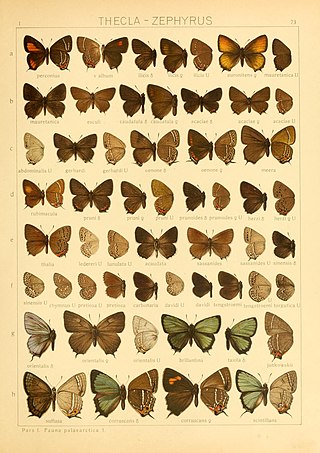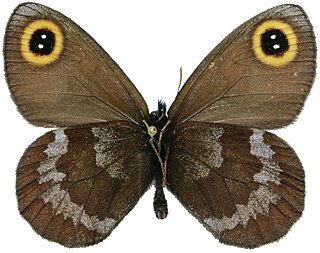
The dark green fritillary is a species of butterfly in the family Nymphalidae. The insect has a wide range in the Palearctic realm - Europe, Morocco, Iran, Siberia, Central Asia, China, Korea, and Japan.

Coenonympha hero, the scarce heath, is a butterfly species belonging to the family Nymphalidae.

Boloria titania, the Titania's fritillary or purple bog fritillary, is a butterfly of the subfamily Heliconiinae of the family Nymphalidae.

Tongeia is a Palearctic genus of butterflies in the family Lycaenidae found in temperate East Asia. Most species are endemic to China and many species are recently described from China. The best known species is the more widely distributed Tongeia fischeri.

Coenophila subrosea, the rosy marsh moth, is a moth of the family Noctuidae. The species was first described by James Francis Stephens in 1829. It is found from southern Great Britain, Italy and France, through central Europe north to Scandinavia, east to Russia, from Siberia to the Amur region, Ussuri and Sakhalin, south to northern China, east to Korea and northern Japan.

Diarsia brunnea, the purple clay, is a moth of the family Noctuidae. The species was first described by Michael Denis and Ignaz Schiffermüller in 1775. It is found in most of Europe, east to Transcaucasia, the Caucasus, central Asia, Siberia, the Kuriles, Amur, Ussuri, Sakhalin, Korea, Japan, and China, including China's Tibet region.

Muschampia tessellum, the tessellated skipper, is a butterfly of the family Hesperiidae. It is found from the southern Balkan Peninsula through Ukraine, southern Russia and Asia Minor, southern Siberia, Mongolia, east to the Amur region.

Neolycaena rhymnus is a butterfly of the family Lycaenidae. It is found from Ukraine and southern and central Russia to the southern Ural Mountains, Zauralye, the western and southern Altai Region, the Sayan Mountains and Kazakhstan. Seitz gives this description - T. rhymnus Ev.. Tailless, the wings brown above and beneath. The underside irrorated with numerous white short dashes, which are partly placed in rows and partly irregularly dispersed. — In South Russia, South Siberia to the Altai, in May and June, on steppes.

Melitaea arduinna, or Freyer's fritillary, is a butterfly of the family Nymphalidae. It is found from south-eastern Europe across Asia Minor to central Asia and the Altai. The habitat consists of steppe-clad slopes.

Erebia cyclopius is a species of butterfly of the subfamily Satyrinae in the family Nymphalidae. It is found through Siberia, northern Mongolia, northern China and North Korea. The habitat consists of forest edges, flowery meadows and sparse larch forests.

Boloria selenis is a species of butterfly in the family Nymphalidae. It is found from the Volga basin to Japan.

Lopinga deidamia is a species of butterfly in the family Nymphalidae. It is found from the Urals to southern Siberia, China, Mongolia, Korea and Japan.
Carterocephalus argyrostigma is a species of butterfly found in the East Palearctic that belongs to the skippers family.

Euphydryas intermedia synonym ichnea is a small butterfly found in the Palearctic that belongs to the browns family. It occurs up to 2200 m above sea level.

Boloria angarensis is a small butterfly found in the Palearctic that belongs to the browns family.

Boloria oscarus is a small butterfly found in the East Palearctic that belongs to the browns family.

Coenonympha amaryllis is a small butterfly found in the East Palearctic that belongs to the browns family.

Neolysandra coelestina is a butterfly found in the Palearctic that belongs to the blues family.

Polyommatus damone is a Palearctic butterfly in the Lycaenidae family.
















